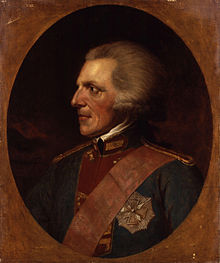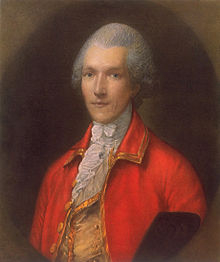Sir Benjamin Thompson, Count Rumford, FRS (German: Reichsgraf von Rumford; March 26, 1753 – August 21, 1814) was an American-born British physicist[1] and inventor whose challenges to established physical theory were part of the 19th-century revolution in thermodynamics. He served as lieutenant-colonel of the King's American Dragoons, part of the British Loyalist forces, during the American Revolutionary War. After the end of the war he moved to London, where his administrative talents were recognized when he was appointed a full colonel, and in 1784 he received a knighthood from King George III. A prolific designer, Thompson also drew designs for warships. He later moved to Bavaria and entered government service there, being appointed Bavarian Army Minister and re-organizing the army, and, in 1791, was made a Count of the Holy Roman Empire.
Sir Benjamin Thompson | |
|---|---|
 | |
| Born | March 26, 1753 |
| Died | August 21, 1814 (aged 61) Paris |
| Nationality | Anglo-American |
| Citizenship | British |
| Known for | Thermodynamics |
| Awards | Copley Medal (1792) Rumford Medal (1800) |
| Scientific career | |
| Fields | Physics |
| Influenced | Humphry Davy |
| Signature | |
Thompson was born in rural Woburn, Massachusetts, on March 26, 1753; his birthplace is preserved as a museum. He was educated mainly at the village school, although he sometimes walked almost ten miles to Cambridge with the older Loammi Baldwin to attend lectures by Professor John Winthrop of Harvard College.
https://en.wikipedia.org/wiki/Benjamin_Thompson

No comments:
Post a Comment